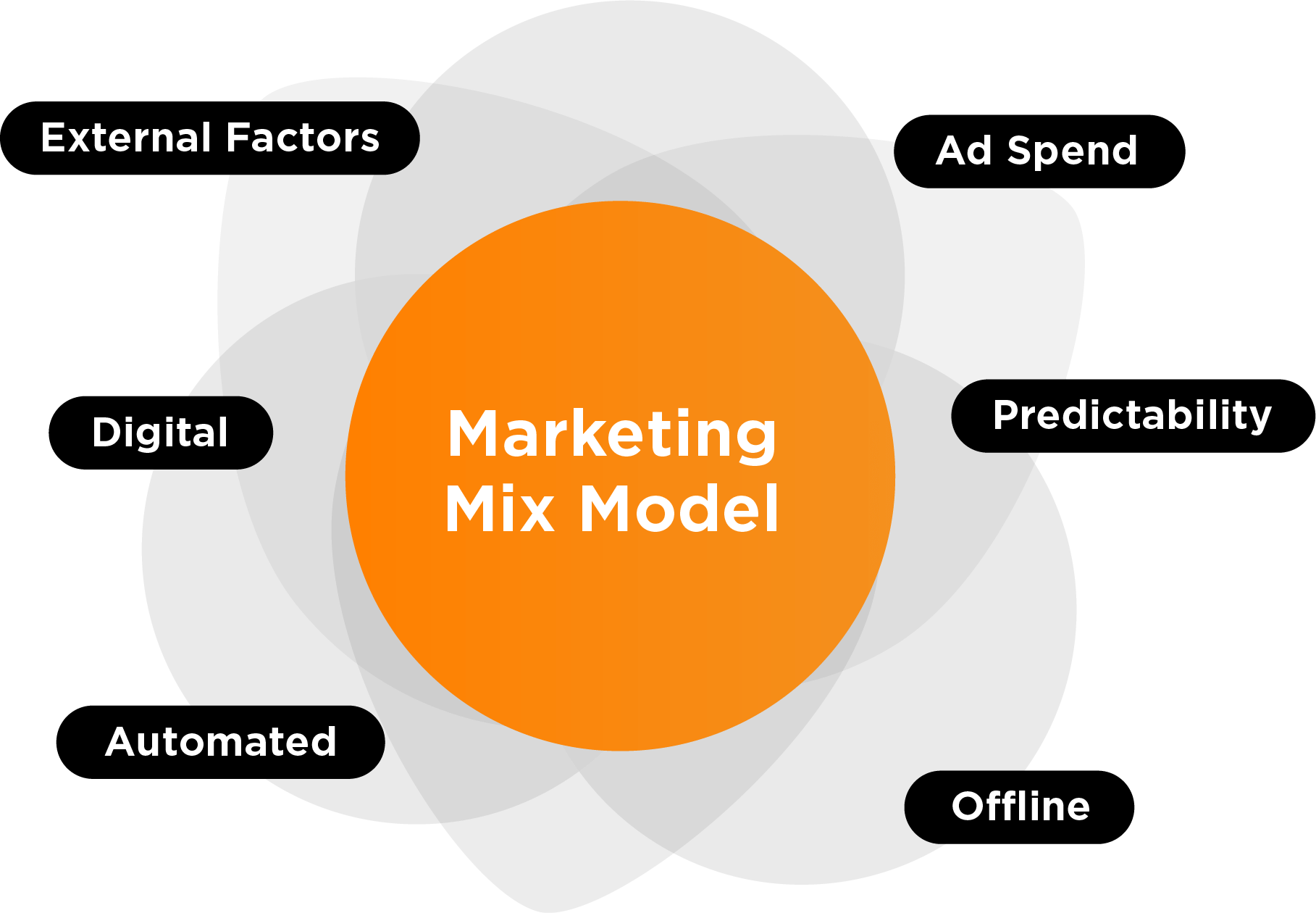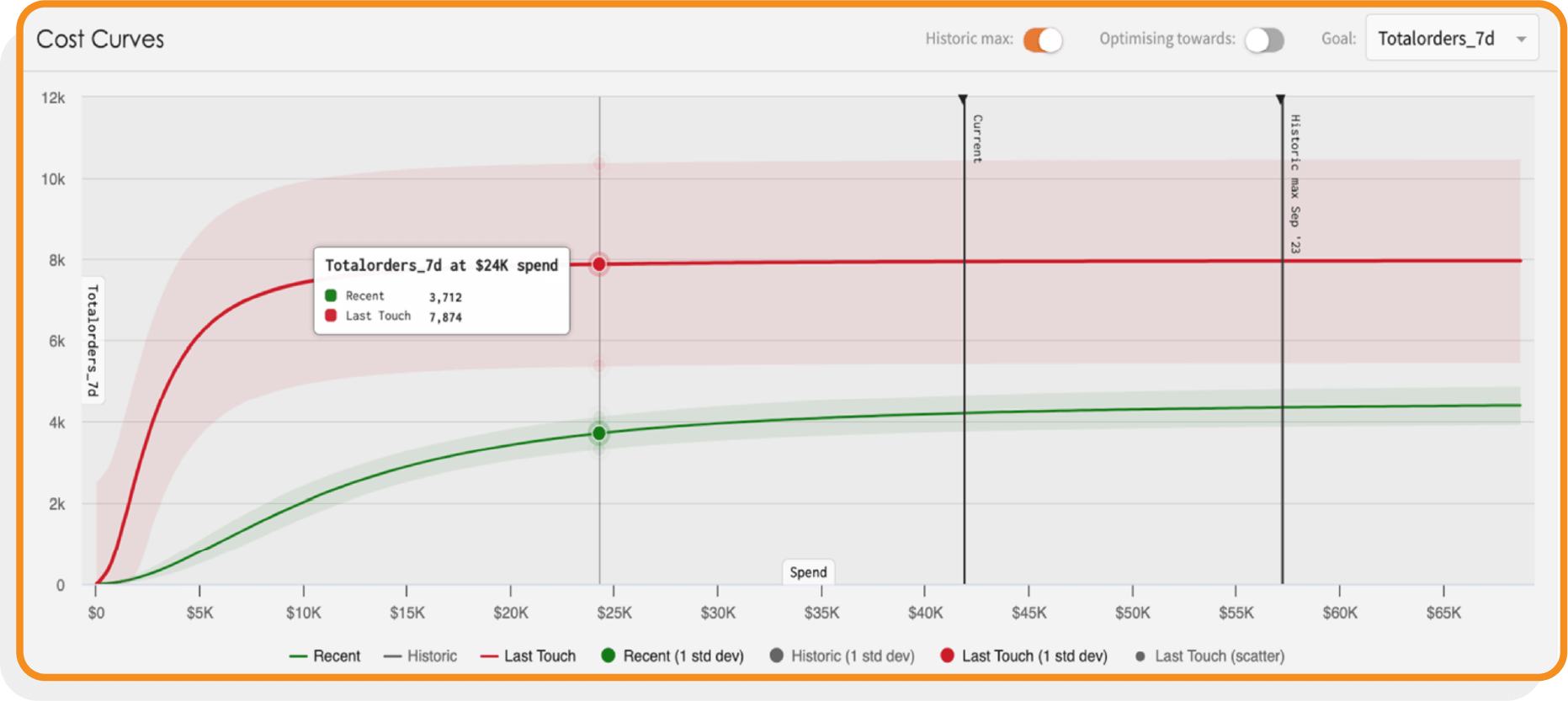How marketing mix modeling orchestrates data-driven success
You’re enveloped in the resonant grandeur of a world-class concert hall. The trumpets announce the opening fanfare of Tchaikovsky’s triumphant Symphony No. 4—unmistakable, commanding. Velvety cellos and soaring violins weave memorable melodies, woodwinds enrich with color and texture, brass instruments deliver moments of thunderous passion—each instrument contributing its unique timbre and counterpoint to create a memorable, synergistic experience. As the whirling finale comes to a close, you are blown away by the massive sound and power of live symphonic music.

No music aficionado would consider ascribing the symphony’s impact to the final dramatic chord immediately preceding your applause. Yet traditional adtech methods—particularly last-touch attribution (LTA)—focus almost exclusively on the final interaction before purchase when measuring marketing effectiveness. While this approach excels at identifying specific conversion triggers, it doesn’t come close to capturing the customer’s traversal through a rich orchestra of marketing touchpoints.
LTA, while straightforward to implement and useful for certain goals, leaves gaps in understanding the full customer journey. Unlike Tchaikovsky’s final chord, the last ad click may garner all the acclaim while the digital out-of-home brand campaign that initially sparked interest, the social media posts that built the buzz, and the email nurture sequence that fostered affinity all vanish from the measurement model. With today’s increasingly complex marketing milieu, relying solely on last interactions can confine strategic decision-making.
Enter marketing mix modeling (MMM), also known as media mix modeling. This analytical methodology captures the full marketing touchpoint symphony, giving advertisers a comprehensive view of all their marketing efforts. Just as a skilled conductor shapes every instrumental nuance, MMM reveals how each element contributes to the magnificent whole.

Harmony from chaos.
Precision from complexity.
Each channel’s contribution to your company’s grand ROAS performance finally made visible.
The Renaissance of Measurement in a Privacy-First World
While attribution modeling traces individual customer touchpoints—like following a single melody line—marketing mix modeling embraces the entire orchestral fabric. The approach quantifies the impact of various marketing initiatives on sales and predicts outcomes of future strategies. By parsing historical data, it evaluates relative performance across channels—from traditional television to digital ensembles—revealing how marketing activities collectively drive success.
As privacy regulations tighten and third-party identifiers deprecate, MMM—which has been around for decades—has regained relevance. The mosaic of modern marketing has grown increasingly intricate precisely as tracking individual user journeys has become more challenging, driving renewed interest in holistic measurement. Like appreciating a symphonic work as a gestalt rather than individual notes, phrases, or instruments, with MMM, the entire ensemble matters.
Beyond Last-Click Myopia
At its core, marketing mix modeling reveals the cumulative impact of all marketing touchpoints across the entire customer journey, from overture to finale, in a privacy-durable way.
Traditional attribution models miss the complexity of today’s shopping odyssey. Advanced measurement partners, however, can now analyze intricate webs of data spanning web, app, CTV, DOOH, and physical retail environments—decoding the full harmonic range of a marketing composition with all its multifaceted instrumentation.
MMM truly shines in its virtuosic handling of external variables. By factoring in seasonality, competitor activity, macroeconomic trends, events, and even weather, MMM isolates their effects from marketing impacts. The clear separation enables marketers to calculate true incrementality—distinguishing between sales that would have occurred naturally and those directly attributable to marketing efforts.
The success of each marketing channel can be understood through three essential components, like evaluating elements of an orchestra:
- Effectiveness: Measuring the actual sales contribution of each marketing effort—like assessing how the clarinets amplify the emotional impact of a passage
- Efficiency: Comparing generated sales to the spend involved—like evaluating the cost-benefit of adding more violinists to the string section
- Return on investment (ROI): The comprehensive metric, considering both sales generated and costs incurred—like determining whether a famous guest soloist sells tickets and delivers a performance worthy of their premium fee

From Annual Ritual to Always-On Insight Engine
The perception of marketing mix modeling as a one-off model with static, spreadsheet-esque outputs has deterred many marketers. Historically, the process resembled a sluggish performance, with data scientists delivering updates semiannually at best—like an orchestra performing just twice a year rather than maintaining a vibrant season.
However, agile next-generation solutions have transformed MMM. Modern AI-powered analytics uncover intricate patterns among marketing activities and outcomes that would elude human analysis. And the tempo has accelerated dramatically—such sophisticated analyses now take days rather than months.
Today’s MMM tools offer model updates daily or weekly rather than quarterly or annually—providing highly actionable insights in near real-time. This evolution makes MMM particularly valuable in today’s privacy-first landscape, where its aggregated approach actually gains effectiveness as individual-level tracking faces a crescendo of restrictions. Agile MMM platforms continuously tune and refine their analysis, ensuring that the marketing composition remains perfectly balanced as market conditions shift and audiences evolve.
The Science Behind the Symphony
Collect
Model
Analyze
Optimize
Effective marketing mix modeling requires several key inputs:
Historical data spanning 1 to 3 years captures long-term trends, seasonality, and business cycles—the rhythm section of model accuracy.
Aggregated market-level data—your sales and conversion figures compiled daily or weekly—serves as the dependent variable against which the model assesses all other elements. Meanwhile, channel-specific expenditures provide the harmonic foundation for understanding marketing impact.
Conversion funnel data mapping the customer journey helps attribute value to different marketing activities at various stages of the path to purchase. This multidimensional view enables marketers to understand not just what works, but when and how it works within the greater customer experience.
External factors—economic indicators, weather conditions, holidays, and significant events—are incorporated as they significantly affect sales beyond marketing efforts. Without these variables, marketers risk misattributing natural fluctuations to campaigns.

From Insight to Action: Outputs That Drive Decisions
Well-executed marketing mix modeling delivers actionable outputs including detailed metrics that assess the contribution of each marketing channel—both online and offline—enabling informed decision-making about budget allocation.
Cost curves identify the point at which additional spend yields diminishing returns. These insights prevent overinvesting in high-performing channels past their efficiency threshold, similar to how adding more brass instruments may lessen impact once the section has reached optimal size.
Channel effectiveness analysis provides data-driven budget recommendations optimizing for specific marketing goals, whether maximizing overall sales, improving cost-per-acquisition, or other KPIs. This guidance transforms abstract insights into concrete spending plans to balance your entire marketing strategy.
Incremental impact measurement separates marketing-driven sales from baseline sales that would have occurred regardless, revealing the true value added by marketing investments. This distinction proves crucial for accurate ROI calculations and budget justification.
Channel synergy insights illuminate how various initiatives work together, helping marketers create more effective, integrated campaigns. Understanding these interrelationships often reveals surprising combinations that amplify overall performance, much like how certain instruments together create surprising sound effects.
The ability to forecast future marketing performance empowers proactive decision-making. MMM’s predictive capability lets marketers test budget allocations before committing resources, reducing risk while maximizing potential returns.
Bridging Team Divides Through Common Metrics
One of the most underappreciated benefits of marketing mix modeling is its diplomatic prowess. By providing a unified measurement framework that evaluates performance across all channels, MMM creates a common language that bridges any gaps between brand and performance marketing teams.
Marketing teams within organizations often operate in silos, each focused on their own objectives and KPIs. MMM provides a unified score that all teams can work from, facilitating genuine collaboration among brand, performance, and product teams, aligning their efforts toward common business goals—shifting any discord to harmony.
This becomes increasingly critical as marketing organizations grow more specialized. When each team optimizes for its own metrics in isolation, the inevitable result is organizational misalignment and suboptimal business performance. MMM provides the holistic view needed to ensure that all teams follow the same beat and contribute to a coherent, integrated marketing strategy that delivers measurable business impact.
Implementation: From Theory to Practice
Setting up marketing mix modeling is remarkably straightforward today. The process involves collecting historical data, consulting with experts, developing models, and integrating data sources—all with significantly less friction than before.
Next-gen software-as-a-service (SaaS) MMM providers have systematically dismantled traditional barriers, creating accessible platforms that guide advertisers through setup with minimal disruption. What once required a specialized data science team now demands little more than marketing expertise and clean, comprehensive data.
While MMM still requires a thoughtful approach and quality data, it’s no longer the resource-intensive behemoth of years past. With the right partner, companies efficiently integrate MMM into their marketing strategy, unlocking deeper insights and optimizing spend for dramatically improved ROI, transitioning from cacophony to music with unprecedented ease.
Summary of Your MMM Options
This table provides a concise summary of your choices when approaching MMM for your organization. Read further to learn about Kochava’s next-gen SaaS solution.
| Feature | SaaS MMM (Including AIM) |
Consultative MMM Services | BYO Internal MMM | Open-Source MMM Products |
|---|---|---|---|---|
| Cost | $-$$$ (scales with use) | $$$ | $$ (high initial, lower ongoing) | $ |
| Customization | Medium | High | High | High |
| Real-Time Capabilities | Yes | No | Possible but not realistic | No |
| Setup Time | Fast | Slow | Slow | Slow |
| Support | Strong client support | Consultant-led | Internal team required | Community-driven |
| Industry Knowledge & Expertise | Regular, industry-wide updates | Extensive, from cross-vertical projects | Limited to internal knowledge | Community-shared expertise |
| Technical Expertise Required | Low to medium | Medium | High | High |
| Ideal For | Marketing teams needing real-time data, scalability, and fast deployment | Large enterprises needing deep customization | Large organizations with extensive resources | Budget-conscious organizations with technical expertise |
The Future: Harmonizing AI and Human Expertise
The convergence of artificial intelligence and marketing science promises to elevate marketing mix modeling to new heights. Next-gen models leverage advanced machine learning to identify complex patterns invisible to traditional methods, revealing the subtle interplay—like exquisite musical textures—that effects true business impact.
The fusion of MMM with AI inaugurates an exciting era in privacy-durable analytics, democratizing advanced marketing measurement for organizations of all sizes—from boutique agencies to global enterprises.
AI-powered automation promises streamlined operations through intelligent orchestration of data flows and privacy controls. Meanwhile, advances in cross-platform integration dissolve longstanding interoperability barriers between MMM and other marketing systems. New privacy-enhancing technologies continue to emerge, driven by innovation and regulatory demands. The result is a measurement approach that maintains privacy compliance while expanding analytical capability—a win-win in today’s complex marketing symphony.
AIM by Kochava: Modern Marketing Maestro
Embodying this future vision is AIM (Always-On Incremental Measurement) by Kochava, a next-gen software-as-a-service MMM platform—your digital maestro. AIM addresses the specific challenges faced by UA marketers by offering a unique approach leveraging advanced, actionable AI-powered machine learning—complex technology made accessible.
Like a brilliant conductor, AIM incorporates market information in real-time, updating models with fresh campaign results. This ensures that decisions stay in tune, optimizing marketing investments with unprecedented precision.

AIM’s feature set harmonizes perfectly with modern marketing needs:
- Optimized budget planning: Leveraging real-time market data, AIM provides automated, optimized budget recommendations, enhancing performance by addressing variables such as seasonality, channel saturation, and incremental gains.
- Continuous learning: AIM adapts and updates daily, ensuring current insights while constantly fine-tuning your marketing ensemble for peak performance.
- Effective data: AIM presents actionable, meaningful MMM data that streamlines marketing investments, bolstering your buying decisions with powerful data science—translating complex data harmonics into clear strategic direction.
- Accurate forecasting: AIM delivers precise performance forecasts, enhancing your decision-making process and ultimately improving your return on investment.
- Powerful scenario planning: AIM enables simulation of different investment scenarios, giving you a clear view of the potential impact on short-, mid-, and long-term performance.
The Virtuoso Advantage
Ready to conduct your own marketing masterpiece? The right MMM solution transforms scattered tactics into a concerto of data-driven performance where every channel plays its optimal role at precisely the right moment. This perfectly orchestrated experience drives not just conversions, but the marketing equivalent of standing ovations: sustained customer loyalty and measurable business growth.
From apprentice to maestro—your journey begins here!
Encore Performance: Your MMM Resource Suite
- Ask Me Anything Webinar On Demand: Watch our expert panel discuss practical MMM applications, implementation, best practices, and common pitfalls.
- TikTok + Kochava MMM Guide: Download our gaming-focused attribution guide created with TikTok for Business for leveraging next-gen MMM for immediate ROAS improvement.
- Personalized MMM Consultation: Request a meeting to discover how AIM by Kochava can orchestrate your specific marketing needs.




